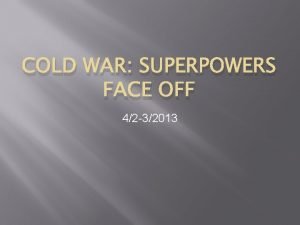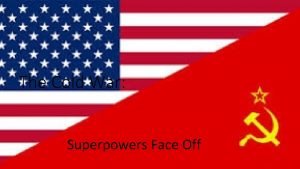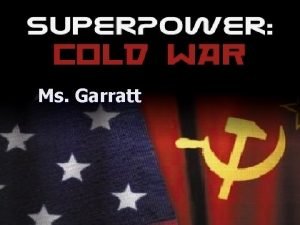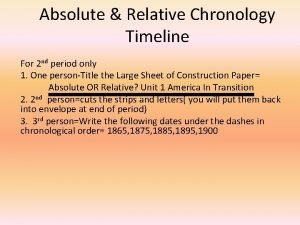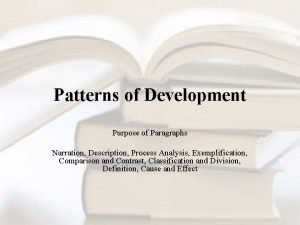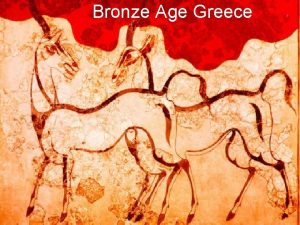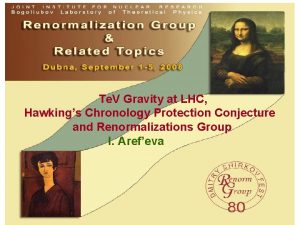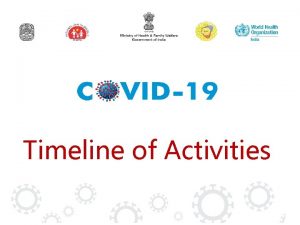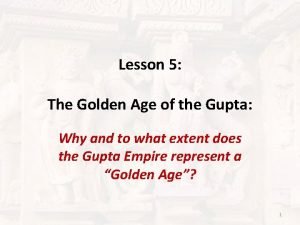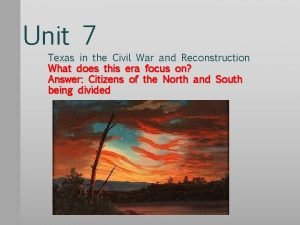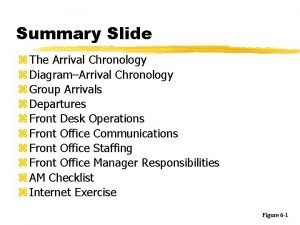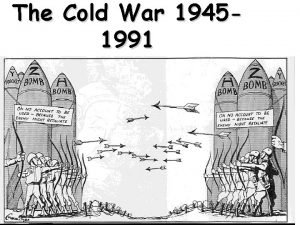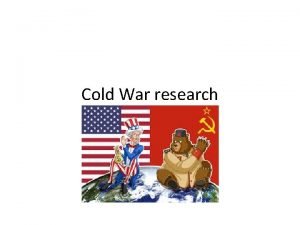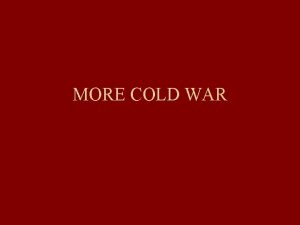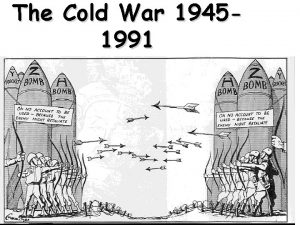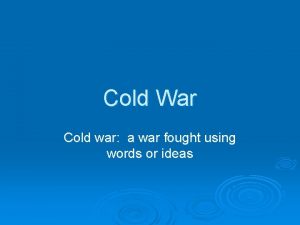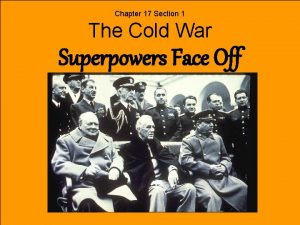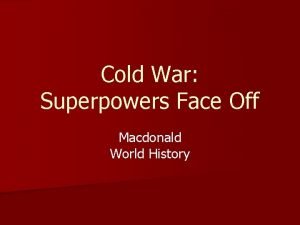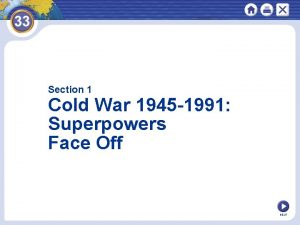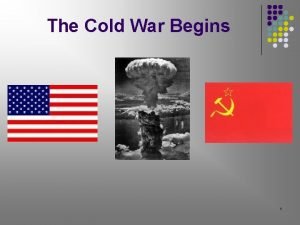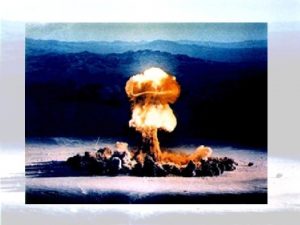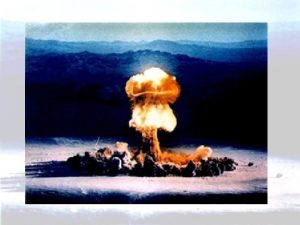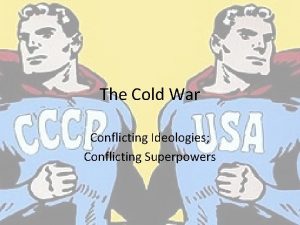Confrontations of the Superpowers The Cold War Chronology





















- Slides: 21

Confrontations of the Superpowers The Cold War

Chronology • • • Truman Doctrine Marshall Plan Berlin Airlift Communists win civil war in China Soviet atomic bomb Formation of NATO Korean War Formation of Warsaw Pact Cuban Missile Crisis / Détente Vietnam War 1947 1948 -1949 1950 -1953 1955 1962 1964 -1973

The Truman Doctrine • U. S. policy must support free peoples resisting attempted subjugation armed minorities and outside pressures • U. S. policy must assist free people to work out their own destinies in their own way • These policies must be implemented primarily through economic and financial aid, the essentials for economic stability and orderly political processes • Truman asked congress for $400 million in aid to Greece and Turkey to contain communism

The Marshall Plan • • • Also known as the European Recovery Program Designed by General George C. Marshall Intended to rebuild prosperity and stability $13 billion for the economic recovery of war-torn Europe The underlying belief was that Communist aggression fed off economic turmoil • To the Soviets, the plan was nothing more than capitalist imperialism • Did not exclude the Soviets or its Eastern European satellites, they refused to participate

The Berlin Airlift • In February 1948 the French, British, and Americans were making plans for the unification of the three Western sections of Germany • Soviets responded with a blockade of West Berlin disallowing train and truck traffic, hoping to halt the unification • 2. 5 million residents needed food and supplies to stay alive • Military action against the blockade and Soviets was ruled out • Up to 13, 000 tons of supplies were flown in to Berlin each day • The Soviets did not interfere for fear of sparking another war, but the crisis severely increased tension • Berlin remained a divided city and a source of much contention

The Cold War Spreads Around the World 1949 -1973 • The Chinese communists win the civil war • Creation of a new communist regime in China intensified American fears about the spread of communism • The Soviet Union detonates its first atomic bomb in 1949 • Escalating arms race resulting in increasingly more destructive nuclear weapons • Security took the form of mutual deterrence • Search for security results in the creation of military alliances

New Military Alliances • NATO – Belgium, Britain, Denmark, France, Iceland, Italy, Luxemburg, the Netherlands, Norway, Portugal, West Germany, Greece, and Turkey • Warsaw Pact – Albania, Bulgaria, Czechoslovakia, East Germany, Hungary, Poland, Romania, and the Soviet Union • CENTO – Turkey, Iraq, Iran, Pakistan, Britain, and the United States • SEATO – United States, Britain, France, Pakistan, Thailand, the Philippines, Australia and New Zealand

Korean War • After the liberation of Korea from the Japanese in 1945 the country was divided into North and South • The thirty-eighth parallel represented the dividing line • North Korea was supported by the Soviets • South Korea received aid from the United States • On June 25, 1950, with the apparent approval of Stalin, North Korea invaded South Korea • Americans saw this as another example of Communist aggression and expansion • With U. N. approval American forces turned back the invaders with plans to unify Korea and root out the communists

Korean War Continued • Mao Zedong sends Chinese forces to reinforce the North Korea • Americans saw the Chinese as a puppet of Moscow and saw communism as a monolithic force directed by the Soviet Union • Two years of fighting produced no conclusive victory • An armistice was reached in 1953 keeping the old dividing line

Implications of the Korean War • Korea seemed to confirm American fears of communist expansion • Reinforced American determination to contain Soviet Power • President Dwight D. Eisenhower adopted a policy of massive retaliation with nuclear weapons to counteract even a Soviet ground attack in Europe • U. S. military alliances were extended around the world

Other events in the 1950’s • 1957 Soviets launch first ICBM • Soviets place first satellite in orbit called the Sputnik I • Another crises in Berlin in 1958 – Khrushchev threatened to blockade – Eisenhower stood firm – Khrushchev backs down • In 1961 Khrushchev gives a 6 -month ultimatum to leave Berlin – Kennedy stood firm like Eisenhower – Khrushchev backs down

The Cuban Missile Crisis • In 1959, Fidel Castro overthrows American backed dictator Fulgencio Batista and established a Soviet supported totalitarian regime • In 1961, Americans supported an attempt to overthrow Castro in an incident called the “Bay of Pigs” • The attempt ended in utter failure • In 1962 the Soviet Union decided to place nuclear missiles in Cuba • The U. S. would not allow such missiles to be 90 miles from the mainland, even though it had installed nuclear missiles in Turkey

The Cuban Missile Crisis • U. S. warships blockade Cuba to keep missiles to reach destination • Khrushchev agreed to turn back the missiles and the U. S agreed not to invade Cuba • The Cold War confrontation between the United States and the Soviet Union reached frightening levels during the Cuban Missile Crisis • Proved that nuclear was within sight • Communication hotline installed between U. S. and U. S. S. R. • The superpowers ban nuclear tests in the atmosphere

Vietnam War • • • Vietnamese forces defeated French colonial masters in 1954 Vietnam was divided in two parts North and South Nationalistic Ho Chi Minh received Soviet aid Ngo Dinh Diem, an autocratic ruler in the South Received U. S. aid Vietcong is in South, sided with Ho Chi Minh Americans overthrow Diem, but the new government is even weaker In 1963, Johnson increases American presence in the South Fighting escalates until Nixon pulls troops out after reaching an agreement with the North Soon after the North overruns the South

U. S. Foreign Policy • Before the Vietnam War there was a consensus by U. S. leaders to contain communism; Cold War Internationalism • Since Vietnam there has been a lack of consensus because of what happened in Vietnam and why.

Competing foreign policy beliefs • Cold War Internationalism • Post-Cold War Internationalism • Semi-Isolationism

Cold War Internationalism • The U. S. and the West must maintain strong military capabilities and willing to use force if necessary to confront Soviet adventurism • Support military victory in Vietnam

Post-Cold War Internationalism • Threats to the world order come from – the gap between rich and poor nations – threats to the environment – population, resources, – racial conflict, trade, – Third World debts, and other international economic issues

Semi-Isolationism • Vital American resources have been squandered on international projects and policing role • Resources should have been spent on solving numerous domestic issues • American policies should be reevaluated recognizing that resources are finite

What is foreign policy? • A set of rules that guides the behavior or actions of a country in its international relations

What factors effect foreign policy? • National characteristics – – – Resources Economy Geography Size “National character” • The international system and behavior of other states • Beliefs, values, and perceptions of leaders
 Cold war
Cold war Superpowers cold war
Superpowers cold war Chapter 17 cold war superpowers face off
Chapter 17 cold war superpowers face off The cold war lesson 1 the cold war begins
The cold war lesson 1 the cold war begins Proxy wars
Proxy wars Nnn superpowers
Nnn superpowers World superpowers over time
World superpowers over time Relative chronology example
Relative chronology example Which should be the chronological order of the paragraphs?
Which should be the chronological order of the paragraphs? Emotional events
Emotional events Iron age dates
Iron age dates What is definition
What is definition Transition words to start a paragraph
Transition words to start a paragraph Medical chronology sample
Medical chronology sample 2200-1500
2200-1500 Chronology protection conjecture
Chronology protection conjecture Timeline of activities
Timeline of activities Chronology of jesus life
Chronology of jesus life Chronology of pauline epistles
Chronology of pauline epistles Chronology of gupta dynasty
Chronology of gupta dynasty Effects of the civil war
Effects of the civil war What steps in the arrival chronology could be shortened
What steps in the arrival chronology could be shortened
